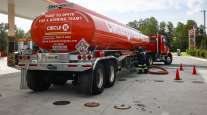Get Ready for the Most Expensive Driving Season in Years

Get ready for a little bit more pain at the pump this summer. Crude oil prices are at the highest level in more than three years and expected to climb higher, pushing up gasoline prices along the way.
The U.S. daily national average for regular gasoline is now $2.81 per gallon. That’s up from about $2.39 per gallon a year ago, according to Oil Price Information Service. And across the U.S., 13% of gas stations are charging $3 per gallon or more, AAA said last week.
“This will be the most expensive driving season since 2014,” said Tom Kloza, global head of energy analysis for Oil Price Information Service.
The price of U.S. crude oil has been on a mostly steady incline since last June and last week hit $68.64, the highest since December 2014. Benchmark U.S. crude closed April 27 at $68.10. Oil prices near $70 shouldn’t put the brakes on economic growth, however. While they’re boosting costs for some sectors of the economy, the energy sector and related industries have more money to spend on equipment and workers.
But higher oil prices are certainly an inconvenience for drivers, especially those with lower incomes.
“The good news is, both at the global level and the U.S. level, this is occurring at a time when growth is fairly robust,” said Nariman Behravesh, chief economist at IHS Markit. “But consumers as a whole will be hurt, mostly because gasoline prices are going up.”
Kevin Lanke, a motion picture lighting technician in Redondo Beach, Calif., says he’s now paying about $3.39 per gallon to fill up the 25-gallon tank in his 2000 Land Cruiser SUV. That’s about 20 cents more per gallon than a couple of months ago.
“I would fill up my car and it would be $52 or $53,” said Lanke, 51. “Now it’s in the mid-$60s for the same amount of gas.”
Lanke keeps the recent increase in perspective, noting that three years ago he and his fellow Californians were paying over $4 per gallon. But he’s already weighing his options, saying if gas goes to $4 a gallon he’ll buy a more fuel-efficient car to use as his main ride and drive the Land Cruiser only when he needs it.
Several factors have helped drive oil prices higher. A wave of global economic growth has driven up demand for oil. At the same time, production cutbacks initiated by OPEC last year have helped whittle down oil supplies.
In the U.S., oil supplies were running 1.1 million barrels lower at the start of this summer’s driving season, which runs from April through September, than a year ago, according to the U.S. Energy Information Administration.
That has amplified the typical increase in gas prices seen this time of year. Pump prices normally rise as demand increases from families going on vacation and taking to the highways on road trips. Already, U.S. consumer demand for gasoline hit a record high for the month of April, according to the EIA.
Drivers in Western states such as California, Oregon and Washington, as well as Alaska, Hawaii, Connecticut and Pennsylvania, are paying the most at the pump. The average retail price in those states is running from $2.95 to $3.61 per gallon.
Average retail gasoline prices are lowest in a swath of mostly East Coast states, including Florida, New Hampshire, Delaware and Georgia. They’re ranging from $2.68 to $2.80 per gallon.
Still, prices remain well off from 2008, when crude oil prices jumped above $130 per barrel and average retail gas prices surged to an all-time high of $4.11 per gallon.
“People forget very, very quickly,” Kloza said, noting that the average U.S. gasoline price remains well below where it stood five years ago at $3.60 per gallon.
“We’re seeing a higher price environment... but I don’t think we’re going to look at really apocalyptic numbers,” he said.
The EIA projects that the U.S. retail price for regular gasoline will average $2.74 per gallon this summer, up from an average of $2.41 per gallon a year earlier. Gas prices rise each spring through Memorial Day and slowly decline as the summer goes along.
Distributed by Tribune Content Agency, LLC




